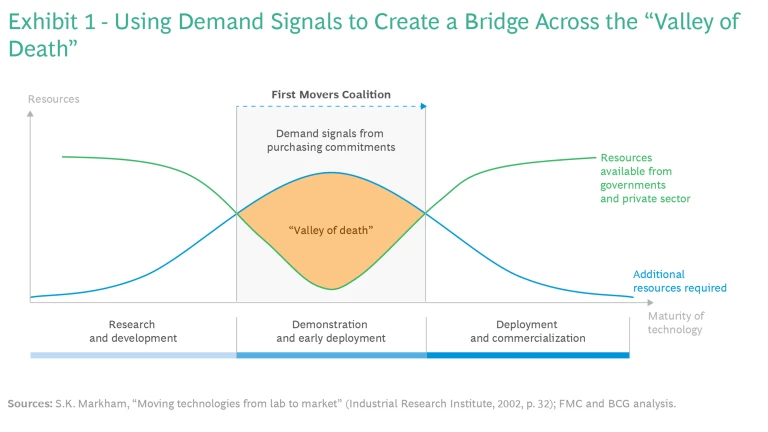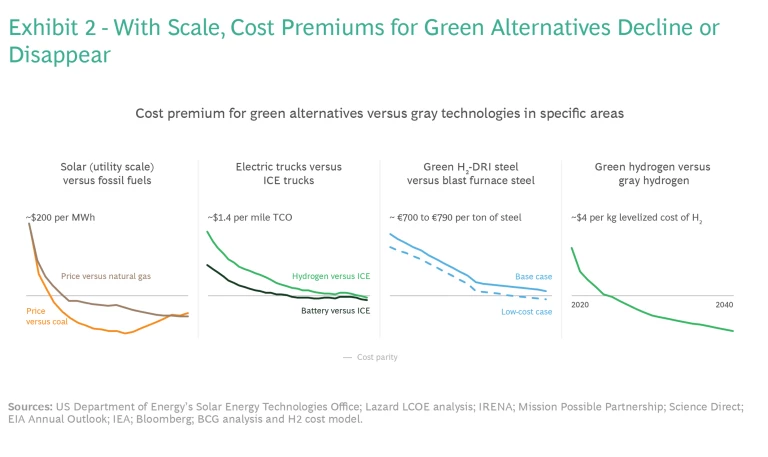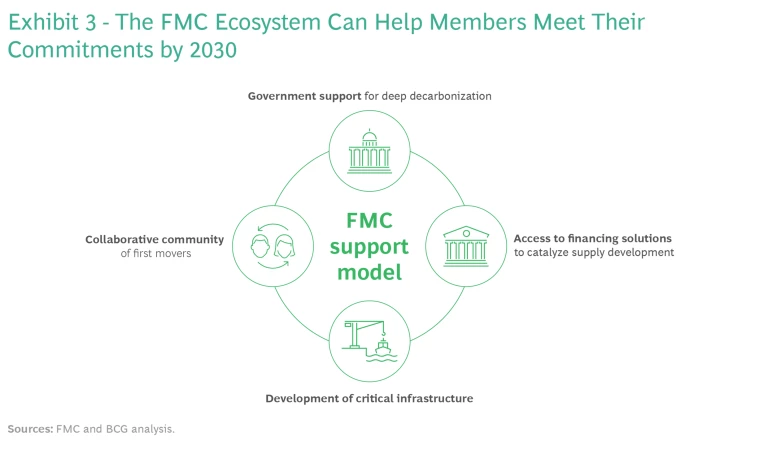A Foreword from Rich Lesser, John Kerry, and Børge Brende
It is against this backdrop that BCG has been proud to work alongside the World Economic Forum and US State Department to help launch the First Movers Coalition, the world’s leading public-private partnership to drive industrial decarbonization. This organization represents a new model that can help companies push the limits on how deeply they can decarbonize and enable them to be successful in the process. Just as importantly, it creates a critical link between business and government to drive visibility to the challenges corporate climate leaders face and accelerate policies that will enable them to decarbonize their operations.
At BCG, we recognize that decarbonization will be deeply challenging for many of our clients. But we also believe that it presents an opportunity to make changes that can create sustainable and lasting advantage as we enter a new era of the industrial economy. We have been proud to help our clients navigate this journey and honored to support the development of new models such as the First Movers Coalition.
Rich Lesser
Global Chair, BCG
I have long said that the scale of the climate crisis is so enormous that it requires a monumental effort not only from governments, but also from the private sector. It was for this reason that at COP26 US President Joe Biden launched the First Movers Coalition, the flagship US public-private partnership on climate, alongside the World Economic Forum.
The First Movers Coalition takes the concept of an early market commitment and applies it to truly innovative technologies in the “hard-to-abate” industries of heavy industry and long-distance transport. Today, the First Movers Coalition has sent the largest demand signal in history: a $12 billion commitment from the private sector to purchase innovative, clean technologies by 2030. The First Movers Coalition has also been bolstered by the support of multiple government partners that not only support the coalition but also seek to enact policy agendas that enable the scale up of First Movers Coalition transformational technologies.
As I reflect on the progress of the First Movers Coalition, I am heartened by the bold and visionary work of our corporate leaders and our government partners. Already, we are beginning to see our private sector members fundamentally shift their businesses in order to meet their 2030 commitments. I truly believe that this is the type of collaborative and ambitious program that is needed to ensure we keep 1.5C within reach and commend our co-chairs at the World Economic Forum as well as our knowledge partners at Boston Consulting Group for the success and the momentum of this program to date.
John Kerry
US Special Presidential Envoy for Climate
The First Movers Coalition is a powerful example of how aggregated demand for innovative decarbonizing technologies through purchasing commitments can achieve ripple effects on a global scale. Through this initiative, the World Economic Forum is actively leveraging the purchasing power of companies to transform our industries in time. Since the launch of the First Movers Coalition at COP26 in Glasgow, the World Economic Forum is looking forward to continued efforts as secretariat to decarbonize industry and long-distance transport toward COP28 and beyond.
Børge Brende
President, World Economic Forum
Steel produced with green hydrogen from solar and wind power. Long-haul airplanes powered by synthetic fuels that produce virtually no emissions. Industrial facilities designed to draw carbon dioxide from ambient air and store it underground.
Technological advances like these are critical for moving a select group of “hard-to-abate” sectors toward a net-zero future. These industries—steel, aluminum, concrete, shipping, trucking, and aviation—generate an astounding 30% of greenhouse gas emissions. Unfortunately, decarbonizing these sectors is significantly more difficult, in technological and financial terms, than is decarbonizing sectors such as electricity generation. Further, these industries are central to what we expect from a modern economy: affordable homes and cars, functioning infrastructure, well-stocked shelves, and a historically unprecedented level of mobility.
The good news is that existing technologies can take hard-to-abate sectors to a net-zero future. In each sector, painstaking research has yielded innovative alternatives that can reduce emissions by 75% to 100%. These technologies have been successfully piloted and demonstrated. All that remains is to expand them to commercial scale.
But scaling decarbonization technologies in hard-to-abate sectors is no easy task. In many cases, green tech pathways remain costlier than their more traditional and carbon-intensive alternatives. Understandably, heavy industry and transportation companies have questions about whether their customers will be willing to pay premiums in traditionally commoditized markets—and the supply-side investments required to implement near-zero-emission technologies range from hundreds of millions to billions of dollars.
The Sustainable Advantage: Insights on Creating Competitive Advantage Through Sustainability
The First Movers Coalition
In light of these challenges, the World Economic Forum, the Office of the US Special Presidential Envoy for Climate, and Boston Consulting Group (acting as the knowledge partner) created the First Movers Coalition (FMC) . Its goal is to accelerate the deployment of critical decarbonization technologies in hard-to-abate sectors. The FMC was launched at the November 2021 UN Climate Change Conference (COP 26) in Glasgow.
Since its inception, the FMC has defined green buying commitments across seven critical sectors: steel, aluminum, concrete, trucking, shipping, aviation, and CO2 removal. As of January 2023, the organization consists of a growing group of blue-chip member companies that have made commitments to buy near-zero-emission products worth an estimated $12 billion in total. And to help create the conditions required for decarbonization, the FMC has assembled a group of government partners that collectively account for half of the world’s GDP.
The coalition’s goal is to accelerate industrial decarbonization by leveraging the power of demand. When the largest companies in the world commit to buying near-zero-emission products, producers of those goods take notice. Commitments to buy green products signal that markets for these products are viable.
What sets the First Movers Coalition apart is its singular focus on scaling deep decarbonization technologies.
This article lays out the theory of change that drives the FMC’s work. Our intention is to clarify the organization’s mission for current and prospective members and to share key insights with other practitioners seeking to harness the power of demand to fight climate change. The discussion addresses four broad topics: driving deep decarbonization, building an FMC sector demand signal, creating an enabling ecosystem, and expanding the power of demand.
Driving Deep Decarbonization
The FMC’s mission—to leverage demand to drive change—is not unique. What sets the FMC apart is its singular focus on scaling deep decarbonization technologies. These technologies are transformational and have the potential to fully decarbonize key industrial processes.
Two other approaches to decarbonization can deliver nearer-term results: incremental technologies, which are bridge innovations that can reduce but not eliminate carbon emissions, and efficiency improvements, which improve on existing processes to lower energy use. Advances in efficiency and incremental technologies are critical in the fight against climate change, but many organizations already focus on these areas. Meanwhile, the next generation of technologies—the step-change innovations needed to reach a net-zero world—have struggled to reach scale. The FMC believes that it can maximize its impact by focusing on the most transformational technologies, so that the three approaches can complement one another in the broader transition ecosystem.
Humanity needs to reach net zero by 2050 to stay on track with the Paris climate goal of limiting the rise in global average temperatures to no more than 1.5°C. Meeting this goal will be impossible without the next generation of technologies, which have a special need for support. They tend to be less mature and more expensive, which renders the investment case for producers substantially more challenging to formulate. Most of all, they need a clear demand signal.

The typical dynamics of the technology development process involve three main phases: research and development, demonstration and early deployment, and deployment and commercialization. (See Exhibit 1.) During the initial stages of research and development for a new technology, funding tends to be more readily available. When the technology is ready to be commercialized, however, those resources dry up. Companies are wary of pursuing new production methods until it’s clear that they will work at scale. Investors are similarly cautious until they are confident that they can recoup their investments.
The challenge of deploying these technologies at scale is not new. In fact, the phenomenon is so well known that it has a name in the innovation literature: the “valley of death.” Many promising new technologies falter at this stage. Some never recover their initial momentum. Many companies instead choose incremental innovation, where the outcomes are more modest but the return on investment is more certain.

The tragedy of this phenomenon is that the discouraging financial barriers are temporary: technology costs fall as usage scales up. As producers deploy the technology more broadly, they learn how to drive efficiencies in laying out facilities and in operating and maintaining equipment. Ultimately, robust supply chains form to meet the needs of the new processes. Solar electricity generation rode this learning curve to become less expensive than fossil fuel generation in just 20 years, and similar dynamics are likely playing out with other key green technologies. (See Exhibit 2.)
By designing its commitments to champion the deployment of the most ambitious viable decarbonization technologies, the FMC believes that it can help accelerate their adoption. The presence of demonstrated demand for near-zero-emission goods and services will incentivize producers and investors to take the leap to build first- and second-of-a-kind industrial projects that they might otherwise deem too risky to pursue.
Building an FMC Sector Demand Signal
The FMC process is based on establishing purchasing commitment frameworks for deep decarbonization technologies. These frameworks are central to the FMC’s mission, and they incorporate three core attributes:
- Technology Forcing. The commitments create an early market to force commercialization of new deep decarbonization technologies.
- Technology Agnostic. The commitments apply to any technology that can reach the required emissions threshold, as long as it can be deployed without creating significant environmental harm. This universal approach fosters competition among viable technologies and avoids placing bets on any particular technological pathway.
- Impact by 2030. The commitments have a 2030 deadline, which requires companies to start planning their procurement now and induces investment in new technologies in the near term.
Demonstrating that demand exists for decarbonized products, even at a cost premium, is critical to catalyzing investments in green production.
Each sector commitment consists of two components: a product-level emissions target and a purchasing requirement. For example, FMC sustainable aviation fuel must reduce emissions by 85%, and airlines must shift 5% of their total jet fuel consumption to such fuel by 2030.
Defining the emissions threshold requires a detailed analysis of the maximum decarbonization possible with known and proven technologies. On the basis of technical input from BCG, industry experts, trade associations, producers, and purchasers, the FMC frames commitments in a way that enables the use of any technology that can drive the desired emissions reduction.
The FMC structures its purchasing requirements to represent only a small portion of a company’s total procurement volume. This design mitigates risk for FMC members, enabling them to make a purchasing commitment that might otherwise be difficult to justify to investors or other stakeholders. After all, FMC members are committing to purchase a product that may not exist yet, at a price that is almost certainly higher than what they pay today. (See “Seven Starting Points for Deep Decarbonization.”)
Seven Starting Points for Deep Decarbonization
Seven Starting Points for Deep Decarbonization
- Alternative Power Sources for Aviation. By 2030, FMC members have committed to replacing at least 5% of conventional jet fuel with sustainable aviation fuels that can reduce emissions by 85% or more. There are promising pathways to achieve this goal, such as next-generation biofuels and power-to-liquid jet fuel, but production remains limited.
- Holistic Changes in Steel Production. FMC members have committed to replacing at least 10% of the steel they purchase with steel produced using near- zero-emission technologies, by 2030. Traditional steelmaking requires massive amounts of fossil fuels, but new near-zero-emission technologies such as hydrogen-powered direct reduction of iron and renewable-powered electric arc furnaces have the potential to reduce emissions by more than 80%.
- Breakthrough Technologies for Aluminum. FMC members have committed to shifting 10% of their primary aluminum purchases to near-zero-emission aluminum by 2030. This material has an emissions reduction factor of up to 85%. It can be produced through less carbon-intensive production technologies such as electric boilers, efficient reuse of steam, carbon capture, fuel substitution, and inert anodes. Many of these technologies are nascent and require significant investments from aluminum producers, but they are critical to achieving the 2050 goal of net zero.
- Near-Zero-Emission Cement and Concrete. FMC members have committed to replacing at least 10% of the cement and concrete they purchase with cement and concrete produced using near-zero-emission technologies, by 2030. These products yield an emissions reduction of 75% to 80%. Technological pathways that can help deliver this reduction include carbon capture use and storage, clinker substitution, and alternative cement chemistries based on binders from nonconventional production processes.
- Zero-Emission Shipping. FMC members have committed to begin using zero-emission shipping fuels such as e-ammonia and e-methanol by 2030. Carriers have committed to ensuring that at least 5% of their deep-sea shipping will use such fuels in 2030, and cargo owners have committed to ensuring that 10% of their internationally delivered goods will travel on zero-emission ships by 2030, on the way to 100% by 2040.
- Zero-Emission Trucks. FMC trucking members have committed to scale up their purchases of zero-emission trucks by 2030. For fleet owners and operators, the commitment covers at least 30% of their heavy-duty truck purchases and 100% of their medium-duty purchases. Retailers and manufacturers will help accelerate this shift by insisting that their trucking service providers meet this standard. The leading technologies in this space—battery electric and hydrogen fuel cell electric powertrains—already exist. But to enable widespread adoption, the sector must address some practical barriers, including the lack of charging infrastructure on key routes.
- A Vibrant Carbon Direct Removal (CDR) Industry. The Intergovernmental Panel on Climate Change estimates that humanity may need to remove between 10 gigatons and 20 gigatons of CO2 per year by 2050, a volume that deployment of nature-based carbon removal solutions alone cannot achieve. Emerging engineered CDR solutions include direct air capture (directly extracting atmospheric CO2), bio-energy carbon capture and storage (capturing carbon in plants, combusting them for energy, and storing the released carbon underground), and enhanced weathering (accelerating naturally occurring rock decomposition, which sequesters carbon). As yet, however, these technologies are very expensive, and they require early investment and deployment to reach scalability at efficient price points.
Once the commitment formulation process is completed, the FMC shifts its focus to recruiting members to build a compelling demand signal. The FMC’s recruiting strategy specifically pursues two critical goals. First, the FMC seeks to aggregate sufficient demand to establish a compelling business case for suppliers to invest in near-zero-emission technologies. Second, the FMC looks to ensure that membership in each sector represents the entirety of the value chain, thereby demonstrating that all stakeholders are committed to shouldering the cost premiums associated with green production.
For example, both airlines and ticket buyers must demonstrate a willingness to pay to make aviation sustainable. This, in turn, will give fuel producers greater confidence that there truly is a market for the next generation of decarbonized jet fuel.
In each hard-to-abate sector, research has yielded innovative alternatives that can reduce emissions by 75% to 100%.
Creating an Enabling Ecosystem
Demonstrating that demand exists for decarbonized products, even at a cost premium, is critical to catalyzing investments in green production. However, a demand signal alone may not be enough. The FMC recognizes that additional action may be necessary to create a favorable environment for suppliers to invest in decarbonization. The organization has identified four key areas of support to stimulate supply creation and help FMC members secure offtake for those products: government support for deep decarbonization, access to financing solutions to catalyze supply development, development of critical infrastructure, and a collaborative community of first movers. (See Exhibit 3.)

Government Support for Deep Decarbonization. The FMC emerged as a public-private partnership in recognition of the power that comes from enlisting governments and companies to act in concert. In addition to the FMC’s private sector members, governments that collectively account for half of the world’s GDP have joined the organization as government partners and are working to help FMC members meet their commitments.
Governments can play a comprehensive role in creating an enabling environment for deep decarbonization—for example, by establishing policies that incentivize innovative technologies. Real policy progress has occurred in recent years, most notably in the form of the US’s 2022 Inflation Reduction Act, but further action is essential to stay on track with Paris goals. The FMC is well positioned to illuminate the obstacles that companies face as they work to decarbonize, thereby providing a basis for governments to effectively target policy action.
Direct procurement by government agencies can make a difference, too. Their sourcing decisions often carry significant purchasing power, particularly in the steel, concrete, and trucking sectors. Government leaders can also call for companies in their markets to join the FMC. In all these ways, a country’s public sector can help drive deep decarbonization and set up its industrial sectors for long-term success.
Access to Financing Solutions to Catalyze Supply Development. Converting industrial production to green pathways capable of meeting FMC commitments demands a significant level of investment. A greenfield or retrofit project leveraging these technological pathways may require hundreds of millions or even billions of dollars of capital over the space of a few years. Typically, investments in these breakthrough technologies rarely occur at commercial scale. Often, they require multiple years of planning and construction before producing cashflow, and the resulting product is usually sold at a premium relative to conventional alternatives, at least at first. This context calls for a unique set of investors that have access to substantial capital, expertise in managing unique risks, and long investment time horizons.
To address this need, the FMC is identifying financing partners that are able and willing to bring the necessary capital to these projects. These partners will also help members structure offtake agreements in ways that make them bankable, thereby creating access to additional financing pools. In addition, the FMC is partnering with government entities such as the US Development Finance Corporation to unlock concessionary funds for building green economies in developing markets, fulfilling opportunities for deep decarbonization that might be less likely to receive investments from private funding sources.
Development of Critical Infrastructure. Some FMC sectors face obstacles related to underlying infrastructure. For example, ships cannot rely on zero-emission shipping fuels such as e-ammonia and e-methanol unless seaports have installed the appropriate bunkering facilities. And electric trucks are of little use to freight companies if they cannot access fast charging to keep their assets operating on the road. Recognizing the challenges faced by members seeking to meet their commitments in these sectors, the FMC has launched an infrastructure pillar to secure commitments from key infrastructure providers. For example, seaports may agree to bunker zero-emission shipping fuels, and highway stakeholders may commit to installing charging infrastructure along key green corridors.
A Collaborative Community of First Movers. The FMC is establishing a collaborative community of first movers across sectors because, even when all of the supporting elements are in place, meeting an FMC commitment is no small task.
FMC members must learn about new technological pathways, understand the expected cost premiums associated with these technologies, vet and catalogue potential suppliers across geographies, and recognize the impact of policy frameworks on the availability and economics of green products. Furthermore, in many instances, members must drive innovation in their own procurement departments, shifting the focus from price improvement to strategic sourcing. In some cases, they may even have to create joint ventures to stimulate supply. To help members navigate these challenges, the FMC holds regular member calls and hosts working groups. Members share information, identify obstacles, and highlight best practices from their experience in pursuing offtake for innovative goods and services.
Expanding the Power of Demand
The FMC is demonstrating that governments and companies can harness purchasing power to build a more sustainable world. Furthermore, there is reason to believe that supply will emerge to meet demonstrated demand. Delta has signed an offtake agreement for approximately half the sustainable aviation fuel it needs to meet its FMC commitment. Scania is on track to shift to near-zero-emission steel for all of its European truck production by 2030. And CEMEX is collaborating with Volvo to develop the first full-size, fully electric concrete mixer. As companies voice their desire to lead in the climate transition, they find suppliers that are willing to accompany them on the journey.
These early signs demonstrate that the FMC model is likely to be a winning one. By harnessing purchasing power and directing it narrowly at breakthrough solutions, we have the potential to accelerate the climate transition at a critical juncture. Augmenting this approach with support from governments, the finance community, and critical infrastructure operators has the potential to remove obstacles to progress that demand alone might not be able to overcome.
The climate transition will pose many challenges, and demand-focused approaches like the one that the FMC employs may have a role to play in solving them. How can we build a more sustainable food system based on decarbonized fertilizers and sustainable agriculture practices? How can we drive circularity to reduce waste and lessen the need for resource extraction and energy-intensive primary production? In real time, we are observing the power that buyers can have when they stand together, and we should carefully consider how to leverage that power to tackle the problems of tomorrow.
Over the next 30 years, our industrial and transportation systems must undergo a fundamental transformation if we are to maintain a climate resembling the one we know today. The FMC is working to help navigate that transition by harnessing the power of demand and by supporting companies that choose to stand at the forefront of the fight. Come join us.














